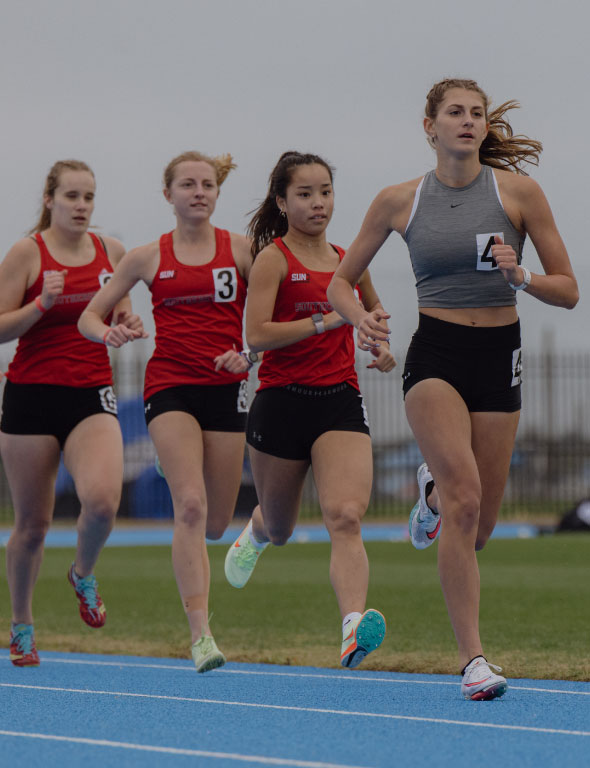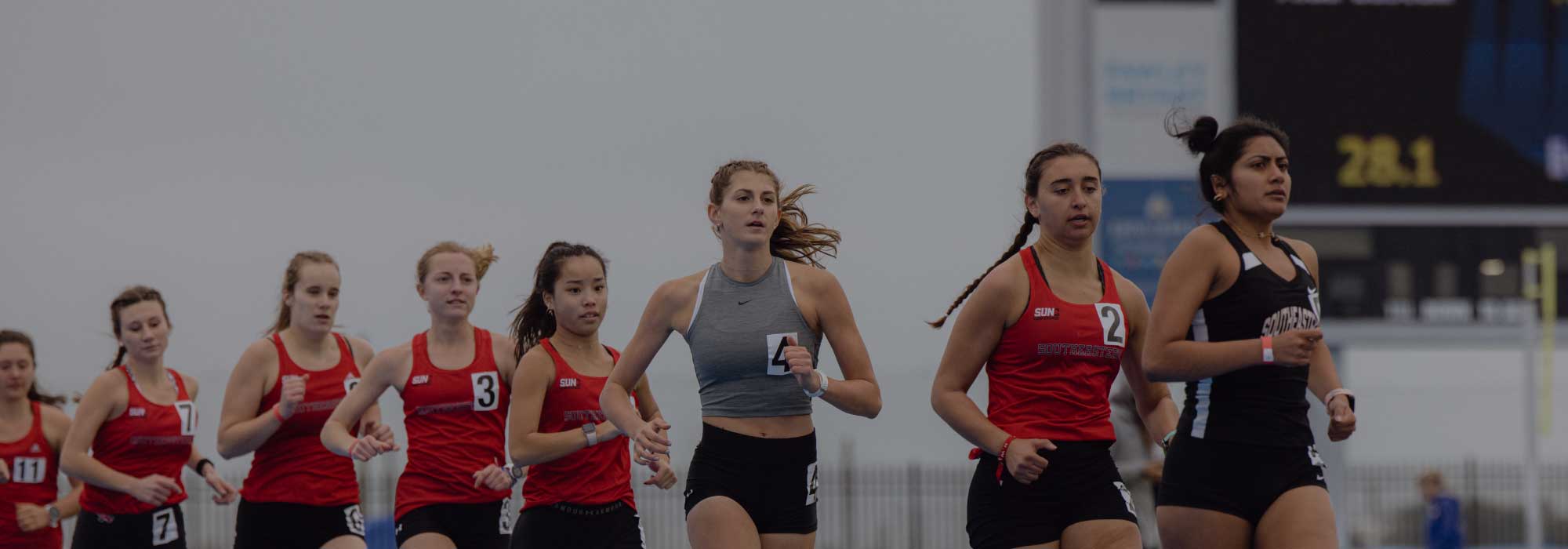Women’s track and field recruiting
There are more than 488,000 track and field high school student athletes competing across the country, but only 2.7% go on to compete at the NCAA Division 1 level, 1.5% at Division 2 and 1.9% at Division 3. The competition doesn’t end there—about 9% of all international student-athletes compete in NCAA Division 1 women’s track and field, making up about 2% of Division 1 rosters. Sure, it can be tough to stand out among the crowd, but recruits who do the leg work get noticed by college coaches.
For example, successful student-athletes build a list of realistic schools, create an online profile and highlight film, understand the recruiting rules and proactively contact college coaches. The different recruiting standards—from NCAA Division 1 to NAIA—and required benchmark times help families find programs that are an athletic fit. But outside of athletics, there’s a lot to consider when researching potential colleges, such as academics, location, size and cost. Even more, coaches look for student-athletes who are leaders, excel in the classroom and have potential to develop throughout their college career.
That’s why this college track and field recruiting guide details all the important factors that go into making your college decision. So, whether you’ve just started your recruiting journey or are already talking with college coaches, this section can help you put your best foot forward.
Review the women’s track and field NCAA recruiting rules and calendar
When can women’s track and field coaches contact student-athletes? The NCAA issues a recruiting calendar each academic year that regulates when—and how—coaches can talk to recruits. These rules are established to protect student-athletes from receiving overwhelming amounts of communication from college coaches.
For college track and field recruiting, contact officially starts on June 15 after sophomore year for NCAA D1 schools. However, depending on the division level, many coaches will evaluate athletes before this point, while others continue to reach out well into senior year. This section breaks down the recruiting rules and calendar, so you can have a better understanding of how coaches at the different division levels approach it.
Understand how to use the women’s track and field recruiting rules and calendar.
Learn how college women’s track and field scholarship standards work
Track scholarships are available for collegiate track and field athletes at the NCAA Division 1 and 2 levels, as well as at NAIA, NJCAA and CCCAA colleges. Each division level has a set of criteria—known as scholarship standards—that athletes are required to meet in order to secure an athletic scholarship. Women’s track and field operates on an equivalency model, meaning coaches are given a maximum number of scholarships they can award. For example, in NCAA Division 1, the average team size is 33 athletes and coaches have 18 scholarships available (schools that aren’t fully funded have even less). Therefore, to make the most of their funds, coaches usually award partial scholarships, leaving student-athletes to pay for some or most of their college costs.
Even though NCAA Division 3 programs can’t offer athletic scholarships, these coaches work with the admissions department to create appealing financial aid packages that can significantly cut college costs. Student-athletes who have their sights set on a track and field scholarship need to be proactive in their recruiting so they can be evaluated by college coaches early on.
How to get recruited by college women’s track and field coaches
There are many opportunities to compete in women’s track and field, with more than 1,000 colleges offering track and field programs. Unlike team sports, the track and field recruiting process is pretty cut and dry. With events being either time, distance or height-based, student-athletes can get a clear understanding of what recruiting standards coaches are looking for.
Here’s where things get tricky: many high school athletes won’t hit the same marks as current college athletes. So, coaches need to gauge an athlete’s potential and project how a recruit might perform once they get to the college level. Even more, there’s an additional layer of competition as women’s track and field recruiting happens on an international level.
To successfully get recruited, student-athletes need to know what marks are needed to compete at each school, proactively reach out to coaches, understand the recruiting rules and calendar, build an online profile and visit college campuses. This section breaks down the most important steps in the recruiting process, so families know exactly what to tackle—and when.
See what it takes to get recruited for women’s track and field.
Attend women’s track and field camps
Track and field camps are a great opportunity to compete against elite runners, jumpers, hurdlers and throwers and see how you stack up against athletes outside of your high school and local competition. It’s a chance for athletes to refine their skills and improve their PRs, while learning more about a staff’s coaching style. Even more, families can check out the school’s campus, explore athletic facilities and potentially meet with coaches and current student-athletes. This section breaks down the different kinds of camps and tournaments student-athletes should have on their radar throughout their recruiting journey—and how to pick the right one.
Find the best track and field camps and tournaments to attend.
Can attending a sports boarding school increase your chance of competing in college?
Maximizing a student-athlete’s chance of being recruited for collegiate track and field is often amplified when he or she has a strong support system in place.
Wondering what a strong support system consists of? Often, families turn to experts like our partner IMG Academy, as they have dedicated college placement advisors, experienced coaches, academic teachers, Athletic & Personal development trainers, mentors, counselors and other staff readily available on campus to support student-athletes. With such a robust support system in place, student-athletes feel prepared and equipped for the next level. Track and field student-athletes will experience a schedule and environment that mirrors that of a collegiate environment, so they’re already familiar with their schedule from the moment they step foot on a college campus.
Within IMG’s college-preparatory environment for 6-12th graders, as well as gap year student-athletes, athletes will:
- Study, train and compete in an environment surrounded by other dedicated student-athletes
- Have access to a competitive academic curriculum, including Honors and AP courses and dedicated study hours
- Increase their exposure to college coaches
- Have access to unparalleled facilities and resources within an all-inclusive campus
- Have a defined competition schedule and annual developmental track
- Participate in annual student activities events, such as Homecoming, Prom, clubs and organizations, beach excursions and more
In addition to leveraging NCSA’s resources, we’ve seen that supplementing your family’s recruiting efforts with IMG Academy’s proven boarding school experience can help student-athletes get recruited for collegiate track and field.
Looking for that extra boost to your performance, but not ready to commit to boarding school? IMG Academy+ offers mental performance and nutrition coaching honed by the experts at IMG Academy from anywhere in the world, on your own device. Click here to start your Essentials membership.
Find Division 1, Division 2, Division 3, NAIA and NJCAA women’s track and field colleges
Between the NCAA, NAIA and NJCAA, over 1,000 colleges offer women’s track and field. When it comes to searching for the best college fit, there are several factors that student-athletes and their families need to think about outside of athletics, including academics, campus life and college costs. To help narrow down your options, we recommend that families analyze colleges from several different angles and create a realistic target list of schools. This guide looks closely at the different division levels and what they have to offer.
Search the complete list of women’s track and field colleges here.
The best women’s college track and field recruiting websites and rankings
While NCSA provides student-athletes with in-depth recruiting education, there are several resources that families can use to learn more about college track and field. For information about state and national rankings of high school athletes, college recruiting news, college track and field rankings and meet information, websites such as USA Track & Field, Track & Field News, Milesplit, FloTrack, Direct Athletics and Athletic.net help families work through their track and field recruiting questions. Check out our college track and field rankings of top programs to find the best college fit at every division level.
View the NCSA Power Rankings for the best women’s college track and field colleges.

